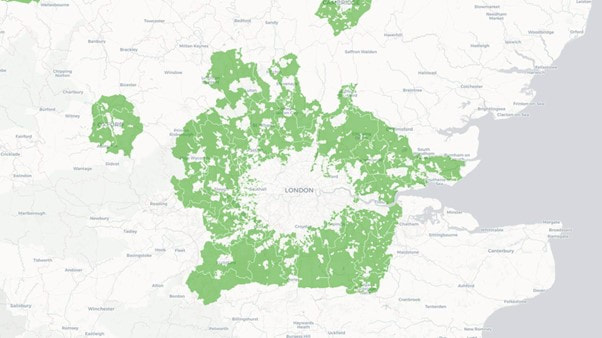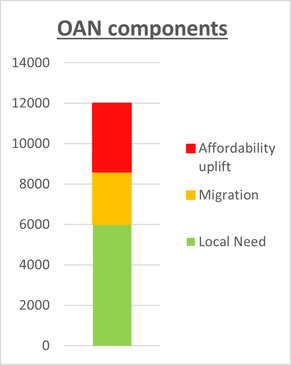Housing Numbers 2022
How many homes does the borough need?
Basildon Council will soon have an “Issues and Options” consultation, which will give the public a say on the general shape of the new Local Plan before it’s written. We welcome this approach.
The most important question they may ask is, how many homes should the borough build over the Plan period? This is likely to cover 20 years, perhaps 2020-2040. So, in this article, we consider the true level of local need.
The most important question they may ask is, how many homes should the borough build over the Plan period? This is likely to cover 20 years, perhaps 2020-2040. So, in this article, we consider the true level of local need.
Fundamentals
- Basildon is obliged to consider something called the “Objectively Assessed Need” (OAN), an inflated and wholly contrived figure set by a government determined algorithm.
- Basildon is extremely fortunate to be located within one of the Green Belts, this means we are not obliged to meet the OAN figure if doing so means removing land from Green Belt.
Basildon is fortunate to lie in one of the Green Belts - most of Essex doesn't enjoy that protection
OAN based on very old data
The OAN for the last Plan as withdrawn in March 2022, was 20,000 homes over 20 years, but this was based on very out of date data and assumptions from 2014. Unfortunately, the government has insisted that Councils continue to use this as the basis of their OAN calculations, even though several sets of more up to date data – including the recent Census – return MUCH lower OAN figures: in Basildon’s case around 12,000 over 20 years. This over stating of the real housing need is seen all over the country.
It seems highly likely that the government will drop its stubborn insistence on outdated data sometime before the next Basildon Local Plan goes to an Inspector, around four years from now.
It seems highly likely that the government will drop its stubborn insistence on outdated data sometime before the next Basildon Local Plan goes to an Inspector, around four years from now.
Need, using current data
Feeding the most up to date data into the government’s algorithm gives an OAN of around 12,000. This is built up of the following components:
- Local Need = 6000
- This is based solely on births and deaths of local people. It could be described as the borough’s true local need.
- Basildon currently exceeds this building rate and can easily continue to do so without using Green Belt.
- Including migration = 8600
- This includes births and deaths, as well as migration into and out of the borough.
- More people move in than out, largely because so many houses have been built in the borough in recent years. The figure assumes the past rate of in-migration will continue.
- Basildon could probably build this many houses without losing any Green Belt land.
- OAN – including the 40% uplift = 12,000
- The government OAN algorithm takes the already inflated 8,600 migration figure and adds a 40% uplift on the basis that a hyper-supply of market homes and accelerated in-migration would reduce house prices.
- There is plenty of evidence, including elsewhere in Essex, that this approach has failed to even slow the increase in house prices.
- Basildon would need to remove land from Green Belt to build this many houses, but of course it is not obliged to meet the OAN if that means using Green Belt land.
Evidence check
During the 10 years from 2011 to 2021 the latest Census data shows that the population of Basildon borough grew by 13,100. A significant proportion of that population increase came from births not directly needing a net new house. Deaths freed up existing properties for the increasing population. Over that period, based on Basildon Council data, there were around 4,600 house completions in the borough. Whilst not all of those new residents will be living in ideal accommodation, some of which may be temporary, there is not widespread homelessness in the borough so it should be assumed that housing supply has largely met need over those 10 years.
The ONS states that population growth is likely to remain at the current level for the next 10 years and may even slow down. We could therefore determine, using simple projections, that the population will grow by c.26,200 over a Local Plan period of 20 years from now, and that a housing target of no more than 9,200 (2 x the delivered 4,600) would meet that growth, comfortably covering the projection of 8,600 from above and assuming that the ineffective affordability uplift is dropped.
Furthermore, in the now withdrawn Local Plan Basildon Council stated that it has identified sufficient brownfield land to deliver 11,000 houses. Whilst some of that land has already been used, we believe that a significant proportion has yet to be developed or repurposed. That available brownfield land, projected against a more appropriate housing target, will show that the council can show a 5-year land supply as demanded by the planning system. Likewise, the previously observed rate of house completions against that target would show that the council can pass the housing delivery test, something it has failed to do when measured against unsubstantiated targets of over 20,000.
The ONS states that population growth is likely to remain at the current level for the next 10 years and may even slow down. We could therefore determine, using simple projections, that the population will grow by c.26,200 over a Local Plan period of 20 years from now, and that a housing target of no more than 9,200 (2 x the delivered 4,600) would meet that growth, comfortably covering the projection of 8,600 from above and assuming that the ineffective affordability uplift is dropped.
Furthermore, in the now withdrawn Local Plan Basildon Council stated that it has identified sufficient brownfield land to deliver 11,000 houses. Whilst some of that land has already been used, we believe that a significant proportion has yet to be developed or repurposed. That available brownfield land, projected against a more appropriate housing target, will show that the council can show a 5-year land supply as demanded by the planning system. Likewise, the previously observed rate of house completions against that target would show that the council can pass the housing delivery test, something it has failed to do when measured against unsubstantiated targets of over 20,000.
Conclusion
There is no perfect housing target, but it can be argued that our true local need can be met without using Green Belt anywhere in the borough. The lowest housing target that Basildon council can put forward is one based on full and optimised use of the available brownfield. This would deliver in the region of 8,000 to 10,000 homes, easily enough to meet local need and observed in-migration at recent rates.
The real housing crisis relates to affordability rather availability, and hyper-supply of market housing will not reduce house prices. Instead, affordability is best addressed by the type of housing rather than the overall number.
BAG will be arguing that the next Local Plan delivers the right number of houses and does all in its limited power to provide “affordable” (as defined in planning circles) and truly affordable (lower cost) homes, such as social housing via the council’s own SEMPRA housebuilder.
Where the houses are built is the next key matter but getting the number right must be the starting point.
The real housing crisis relates to affordability rather availability, and hyper-supply of market housing will not reduce house prices. Instead, affordability is best addressed by the type of housing rather than the overall number.
BAG will be arguing that the next Local Plan delivers the right number of houses and does all in its limited power to provide “affordable” (as defined in planning circles) and truly affordable (lower cost) homes, such as social housing via the council’s own SEMPRA housebuilder.
Where the houses are built is the next key matter but getting the number right must be the starting point.
A pdf of this article can be downloaded by clicking below.
| bag_basildon_local_plan_housing_numbers_2022.pdf | |
| File Size: | 291 kb |
| File Type: | |





